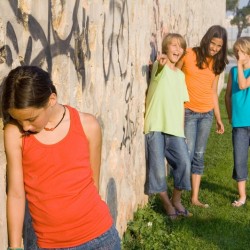 How do parents help kids deal with bullying, without helicoptering? I’ve seen several recent articles, written by both parents and researchers, suggesting that the silver lining to parental non-involvement in kids’ bullying is that kids (1) learn to work problems out for themselves and (2) accept the life lesson that not everyone’s going to be your friend. This is an overly simplistic approach –- let me explain why.
How do parents help kids deal with bullying, without helicoptering? I’ve seen several recent articles, written by both parents and researchers, suggesting that the silver lining to parental non-involvement in kids’ bullying is that kids (1) learn to work problems out for themselves and (2) accept the life lesson that not everyone’s going to be your friend. This is an overly simplistic approach –- let me explain why.
With bullying, kids should never be left to fend for themselves. “Let the kids work it out” is never an appropriate response to bullying and is only appropriate for conflicts, where the power balance is equal and children have received months (some would say years) of adult-assisted instruction and practice in choosing from a list of structured solutions. Far too often, children find themselves hurt or in danger, powerless, frightened, desperately needing help, and unaided by peers or adults (parents or teachers). Children need to know that adults will protect them from harm.
While the headline-grabbing bullying catastrophes are mostly played out in middle and high school, the breadcrumb trail begins in pre-school. Behavioral patterns become encoded with repetition –- for bullies, targets, and bystanders. Adults should intervene early, before exclusion and bullying escalate. Early intervention will stop the problem at its least pernicious stage, giving kids the clear knowledge that adults are watching and will step in. When adults are consistent, stopping bullying at every opportunity, kids will internalize the message and stop testing to see if adults really mean it. “No bullying” slogans on the first day of school or the first day of summer vacation at home are meaningless if not backed up by consistent adult monitoring and action. And if adults want to be seen as credible guides and mentors to children, then we should spend some time cleaning up bullying in adult workplaces and communities. That’s a topic on its own!
Our kids should know how to treat themselves with respect, too, even when others aren’t treating them so well. This means knowing when to stop chasing relationships with frenemies, a good skill for adults and kids. Kids grounded in respect for themselves and others won’t bully others and won’t stand by and watch others being bullied. Adults can teach kids how to move in closer when their friends treat them with respect and how to back off when the friendship isn’t going so well. It’s important that children have friendships in several social groups, so their social life doesn’t end if they’re on the outs with one friend (more a problem for girls than boys).
Some kids are more sensitive, some less. Parents and other adults can help sensitive kids learn coping skills to manage and tone down their sensitivity and the social skills to make and nurture friendships. We must help all kids develop the resiliency skills to roll with life’s ups and downs. Teasing and competition are a valuable part of childhood, imparting crucial life skills and even fostering brain development. Learn how to recognize when the line is crossed into mean-spirited taunting and exclusion. We all make mistakes, but the difference between a mistake and bullying is how quickly the bullying stops once the line has been crossed.
Bullying IS all bad. Adults need to stop looking the other way until there’s a crisis, whether it’s ” She hit me” in pre-kindergarten or ” Why don’t you just go kill yourself”, thrown with contempt at 14-year-old new immigrant Phoebe Prince in South Hadley, MA, who did, indeed, go home and kill herself after months of verbal, physical, online, and face-to-face bullying, often in full view of peers and school officials. If we start in kindergarten, teaching our kids appropriate boundaries for how we treat other human beings, inclusivity for all, the skills of emotional self-control (especially under stress), and building the value of everyday bystander intervention (we are required to help others in physical and emotional danger), we can turn the tide of children’s bullying. The central message of bullying prevention is simple, but not always easy: You don’t have to love everyone, you don’t have to be everyone’s best friend, but we must make a place for everyone and we must be able to play and work with everyone. No exceptions. Make every day Bullying Prevention Day.
1. D. Derbyshire, “Why It’s Not Always Bad To Be Bullied: Learning To Fight Back Helps Children Mature, Says Study”, DailyMail.co.uk, May 24, 2010
2. A. Hatch, “Dealing With Bullying: It’s Not all Bad”, Huffington Post.com, July 25, 2011

